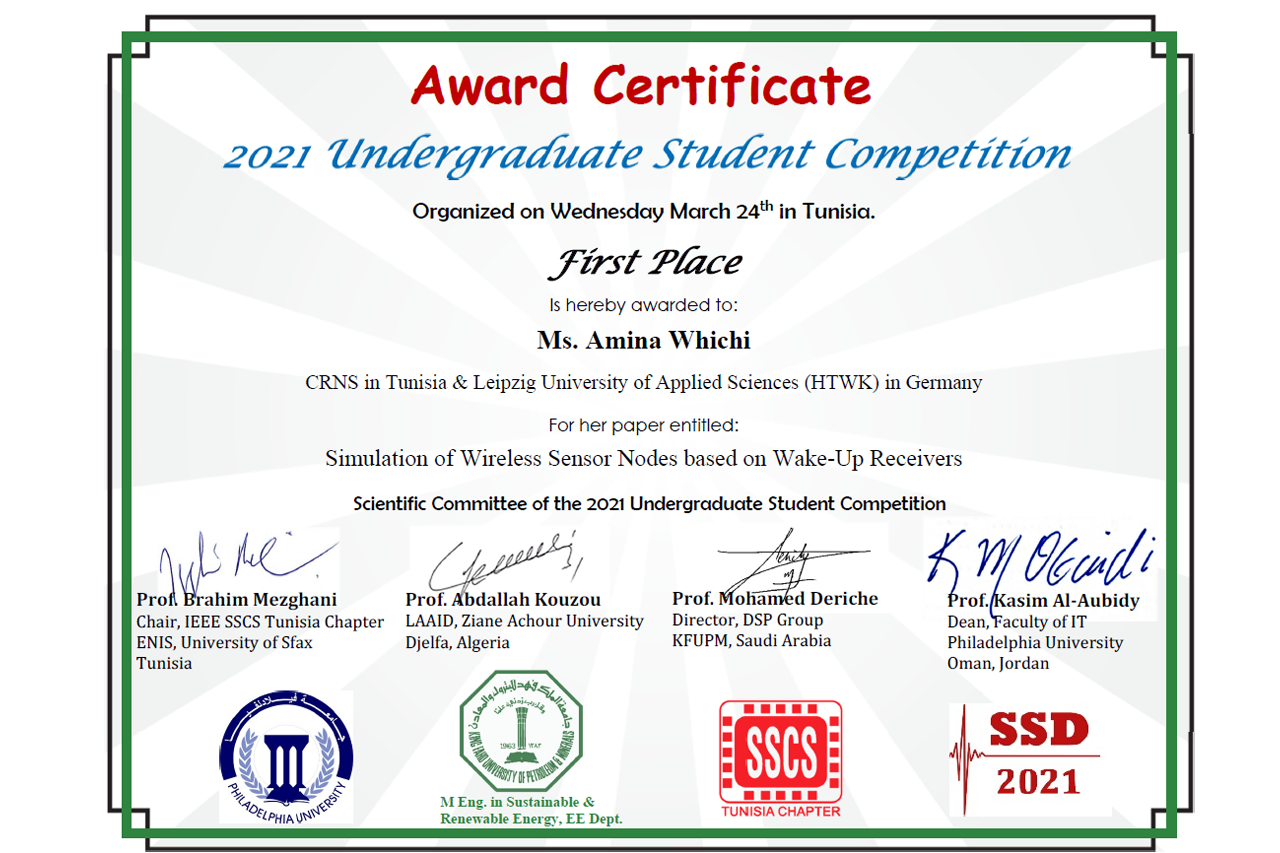Whichi's thesis on Wireless Sensor Networks (WSN) was supervised by Prof Faouzi Derbel, Faculty of Engineering at HTWK Leipzig.
Amina Whichi, an electronics and communications engineer, was awarded first prize in the 2021 Undergraduate Student Competition in Tunisia on 24 March 2021 for her final thesis entitled "Simulation of Wireless Sensor Nodes based on Wake-Up Receivers". Whichi was supervised in her final project on Wireless Sensor Networks (WSN) by Prof Faouzi Derbel, Faculty of Engineering at HTWK Leipzig.
In her final thesis, engineer Amina Whichi focussed on the sensor nodes of the Wireless Sensor Network (WSN).
The WSN (sensor network) is considered a key technology for digitalisation and the realisation of the Internet of Things (IoT). To achieve this, however, the components of the WSN must be characterised by low energy consumption and high data transmission quality.
Amina Whichi sees wake-up receivers (WuRx) as a promising solution. In contrast to conventional radio technology, WuRx technology enables energy-autonomous, on-demand transmission hardware for continuous monitoring of the transmission channel, emphasises the engineer. To test her assumption, she used OMNeT++ to simulate a virtual sensor module that replicates the properties of real WuRx. The results of her simulations showed that the WuRx technology offers lower energy consumption and good reliability compared to conventional radio transmission technology.
With her award-winning final thesis on WuRx technology, Amina Whichi successfully completed her three-year degree in "Electronics and Communications Engineering" specialising in "Embedded Systems" at ENET`com in Sfax (Tunisia).
Young engineer Amina Whichi would soon like to write her dissertation under the supervision of Prof Faouzi Derbel and work even more intensively on wake-up receivers and tracking and localisation technology.
Simulation of Wireless Sensor Nodes based on Wake-Up Receivers
Abstract
The Wireless Sensor Network (WSN) is one of the most promising solutions for the digitisation in context of Internet of Things (IoT). Despite all research activities, there are still many challenges to be solved as power consumption and quality of service (QoS) for which the Wake-up Receiver (WuRx) offers a promising approach. This technology allows energy-autonomous on-demand communication hardware for continuous monitoring of the communication channel instead of the conventional radio. Since it is often not possible to create a large-scale testbed due to material costs and time, it is necessary to rely on a virtual solution. To create, test and develop a Wake-up Receiver based WSN in a controlled and reproducible manner, a software-based simulation tool is used.
This work presents a comparison of the most cited simulation tools in literature regarding communication mechanisms based on Wake-up Receivers. In detail, the simulation tools MATLAB, NS-2/NS-3, OMNeT++ and NetSim are considered. Based on this evaluation OMNeT++ was chosen to develop a sensor module that replicates the functionalities of the WuRx. This module was used to demonstrate main advantages of the WuRx based communication compared to the conventional communication of wireless sensor nodes using X-MAC and BMAC protocols. The results have shown that the WuRx approach is better than conventional MAC communication mechanisms in terms of energy efficiency and reliability.

